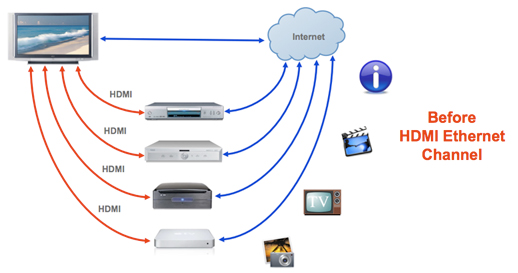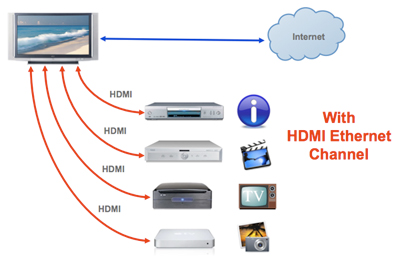So, it's happening... HDMI 1.4 is in the final stages of work, and will likely be released within the month. You can expect to see products start showing up after New Year's, and more prevalent throughout 2010. Here's what you need to know.
- First, HDMI is trying to move away from using versions like "1.3" or "1.4". Their rationale kind of makes sense, although it makes it even more complicated/involved than it already is. Trying to keep this discussion brief, the problem is that products need hardly anything to call itself "HDMI 1.x compliant". Each version number comes with a list of multiple new features that it includes, but it is up to the manufacturer as to which ones, if any, their product actually supports. Example: HDMI 1.3 included "Deep Color", but Brand X could make a product labeled "HDMI 1.3 compliant" without supporting the Deep Color feature. So instead of version numbers, HDMI is trying to push products to list the exact features it supports. Obviously, this will be more confusion to Joe 6-Pack, even if it's more detailed and accurate.
- Second, we as people naturally think that if we have version "26" of something, then when version "27" comes out, it's got to be newer, better, and we need it. Not always necessarily the case with HDMI features.
- In this case, HDMI 1.4 can be summarized as new features that either make current operations simpler, or enable future technologies. But it is not essential for new current technologies. Therefore, new compliant products will be cool, but you don't need to dump your current gear just to get new "HDMI 1.4" stuff.
New features in the HDMI 1.4 set:
- 2-WAY ETHERNET OVER HDMI. This will be the "coolest" main feature. HDMI will now be able to carry ethernet data (i.e. internet connection, etc) in addition to current audio/video, with no compromise in quality to anything. Bottom line, this means that your ethernet-enabled device will now only need an HDMI connection from the source, instead of HDMI for A/V, and ethernet Cat "x" cable for data. If your device already has ethernet, this will not enable anything new that your device can't already do, or provide any higher/faster quality, but it will use just 1 cable instead of 2. Not essential, but a simpler setup. (see below under "other things" for one small caveat)
- RETURN AUDIO CHANNEL. This will enable not only audio and video going from your source (i.e. disc player, receiver) to your display, (i.e. TV) but now you can also stream audio BACK from your display to your source as well, over the same single cable. Consider that if your TV has an onboard ATSC tuner, you can watch TV directly on the display, but previously if you wanted to send the sound back to your receiver for home theater, you had to hook up separate cables for the output. Now, again, it will just be consolidated into one cable, instead of using one HDMI for A/V output, and another cable or two of some sort for input back to the receiver. Only a simpler setup. This will have capabilities up to SPDIF-level. (i.e. up to Dolby Digital or such... can't do Dolby True HD or such)
- 3D CAPABILITY. This is one of the future technologies. CEDIA 2009 had all sorts of video displays showing 3D capability. But consider, that even if you bought one today, currently no real 3D media exists. Personally, I wonder if this is really going to go anywhere. I wasn't overwhelmed by the 3D demos that I saw. I'd rather view something in pristine 1080p perfect color, than gimmicky 3D. So... this one's nice to have for future tech, but not essential.
- UP TO "4k2k" RESOLUTION. Another future technology. "4k2k" resolution refers to future resolution capability beyond 1080p, such as 3840x2160 at 24/25/30 Hz, or 4096x2160 at 30 Hz. Will this happen someday? Undoubtedly. But again, no media exists today for this, and there's no global standard for these resolutions, like there is for 720p, 1080i/p.
- EVEN MORE COLOR CAPABILITY. Without going into details, HDMI 1.4 allows even more expanded display of the color spectrum. This was started in 1.3 with Deep Color. Again, though, to really make this tech happen, you'd have to have both the display and source properly utilize it. Not going to be mainstream, at least for a while.
Other things HDMI is working on, not really part of the HDMI 1.4 standards:
- Most important thing, the ONLY thing you'll need to know about upgrading your current HDMI cables, is that your current cables will support ALL new features of HDMI 1.4, *EXCEPT* the ethernet channel. So if you're not going to use ethernet over HDMI, your current cables are fine. Otherwise, you gotta buy new HDMI cables capable of ethernet, too.
- Micro HDMI. This will be a new plug, about the size of a Micro USB plug, with the same performance as a full HDMI jack. You'll probably start seeing this on things like digital video cameras.
- Automotive connector w/lock. You'll start seeing HDMI in cars, like mobile video entertainment systems built-in. You can bring your disc player and plug in the video to the car for play on the car displays. Because of car movement/vibrations, these connectors will be more stable.
- Labeling will change and be standardized for HDMI cables. Soon, (through 2010) you won't see any more "HDMI 1.3" or "1.4" cables, they'll have different word categories. Basically, what you're going to want to buy will be called "High Speed HDMI Cable w/Ethernet".
Confused yet?
- First, HDMI is trying to move away from using versions like "1.3" or "1.4". Their rationale kind of makes sense, although it makes it even more complicated/involved than it already is. Trying to keep this discussion brief, the problem is that products need hardly anything to call itself "HDMI 1.x compliant". Each version number comes with a list of multiple new features that it includes, but it is up to the manufacturer as to which ones, if any, their product actually supports. Example: HDMI 1.3 included "Deep Color", but Brand X could make a product labeled "HDMI 1.3 compliant" without supporting the Deep Color feature. So instead of version numbers, HDMI is trying to push products to list the exact features it supports. Obviously, this will be more confusion to Joe 6-Pack, even if it's more detailed and accurate.
- Second, we as people naturally think that if we have version "26" of something, then when version "27" comes out, it's got to be newer, better, and we need it. Not always necessarily the case with HDMI features.
- In this case, HDMI 1.4 can be summarized as new features that either make current operations simpler, or enable future technologies. But it is not essential for new current technologies. Therefore, new compliant products will be cool, but you don't need to dump your current gear just to get new "HDMI 1.4" stuff.
New features in the HDMI 1.4 set:
- 2-WAY ETHERNET OVER HDMI. This will be the "coolest" main feature. HDMI will now be able to carry ethernet data (i.e. internet connection, etc) in addition to current audio/video, with no compromise in quality to anything. Bottom line, this means that your ethernet-enabled device will now only need an HDMI connection from the source, instead of HDMI for A/V, and ethernet Cat "x" cable for data. If your device already has ethernet, this will not enable anything new that your device can't already do, or provide any higher/faster quality, but it will use just 1 cable instead of 2. Not essential, but a simpler setup. (see below under "other things" for one small caveat)
- RETURN AUDIO CHANNEL. This will enable not only audio and video going from your source (i.e. disc player, receiver) to your display, (i.e. TV) but now you can also stream audio BACK from your display to your source as well, over the same single cable. Consider that if your TV has an onboard ATSC tuner, you can watch TV directly on the display, but previously if you wanted to send the sound back to your receiver for home theater, you had to hook up separate cables for the output. Now, again, it will just be consolidated into one cable, instead of using one HDMI for A/V output, and another cable or two of some sort for input back to the receiver. Only a simpler setup. This will have capabilities up to SPDIF-level. (i.e. up to Dolby Digital or such... can't do Dolby True HD or such)
- 3D CAPABILITY. This is one of the future technologies. CEDIA 2009 had all sorts of video displays showing 3D capability. But consider, that even if you bought one today, currently no real 3D media exists. Personally, I wonder if this is really going to go anywhere. I wasn't overwhelmed by the 3D demos that I saw. I'd rather view something in pristine 1080p perfect color, than gimmicky 3D. So... this one's nice to have for future tech, but not essential.
- UP TO "4k2k" RESOLUTION. Another future technology. "4k2k" resolution refers to future resolution capability beyond 1080p, such as 3840x2160 at 24/25/30 Hz, or 4096x2160 at 30 Hz. Will this happen someday? Undoubtedly. But again, no media exists today for this, and there's no global standard for these resolutions, like there is for 720p, 1080i/p.
- EVEN MORE COLOR CAPABILITY. Without going into details, HDMI 1.4 allows even more expanded display of the color spectrum. This was started in 1.3 with Deep Color. Again, though, to really make this tech happen, you'd have to have both the display and source properly utilize it. Not going to be mainstream, at least for a while.
Other things HDMI is working on, not really part of the HDMI 1.4 standards:
- Most important thing, the ONLY thing you'll need to know about upgrading your current HDMI cables, is that your current cables will support ALL new features of HDMI 1.4, *EXCEPT* the ethernet channel. So if you're not going to use ethernet over HDMI, your current cables are fine. Otherwise, you gotta buy new HDMI cables capable of ethernet, too.
- Micro HDMI. This will be a new plug, about the size of a Micro USB plug, with the same performance as a full HDMI jack. You'll probably start seeing this on things like digital video cameras.
- Automotive connector w/lock. You'll start seeing HDMI in cars, like mobile video entertainment systems built-in. You can bring your disc player and plug in the video to the car for play on the car displays. Because of car movement/vibrations, these connectors will be more stable.
- Labeling will change and be standardized for HDMI cables. Soon, (through 2010) you won't see any more "HDMI 1.3" or "1.4" cables, they'll have different word categories. Basically, what you're going to want to buy will be called "High Speed HDMI Cable w/Ethernet".
Confused yet?








Comment